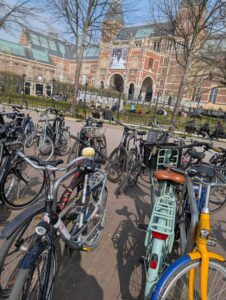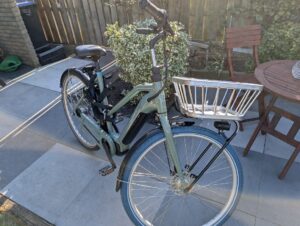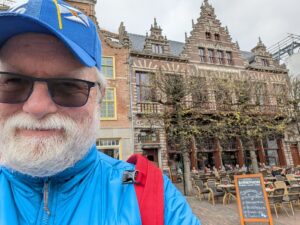 I came to the Netherlands for two reasons. One was to study the Dutch bicycling infrastructure and understand why it works.
I came to the Netherlands for two reasons. One was to study the Dutch bicycling infrastructure and understand why it works.
The second was to get “stuck in,” that is to be, for a while, part of a place rather than a spectator.
I’ve found real answers to the first question. The answers are density and land use.
 The Netherlands is densely populated, and land use makes it denser still. This land has more to do than hold people and their stuff. It also feeds the world, and it must provide resilience against a constantly changing climate where most people live below sea level.
The Netherlands is densely populated, and land use makes it denser still. This land has more to do than hold people and their stuff. It also feeds the world, and it must provide resilience against a constantly changing climate where most people live below sea level.
By leaving land empty and wild, water has somewhere to go. The wildness is planned and managed. One byproduct is biological diversity and places you can go when urban life gets you down.
Density means homes are small and people are close together. You must get along. The community and its needs leave no choice. But it’s because of density that bikes are the default way of getting around.
This way of life is now threatened by fat tired “Class 3” e-bikes, and motorcycles. The fat tire bikes offer comfort and speed within the confines of a bike-based city. The motorcycles provide both speed and range. Seeing them on Utrecht bike paths, and young people gravitating toward them, breathing the motorcyclists’ exhaust, makes me fear for the bicycling future here.
Riding With Style
 Speaking of the bike, I have finally figured the Swapfiets out.
Speaking of the bike, I have finally figured the Swapfiets out.
First, the basket on the front had to go. It’s fine if all you’re doing is shopping, not fine if you’re riding 20 miles (30 km) a day, as I am. Putting it aside gives me control over the front wheel.
I’ve also learned the key to riding an e-bike is to relax. You’re here to watch the road, not fight your way along it. I turn the power level up to 2 immediately and go 15 kph (10 mph). I turn it up to 3 when I’m out of the crowds and relax at 25 (15 mph). You don’t have to push it, the e-bike will go along fine if you pedal against the minimal resistance.
I do miss my Edison’s mini-throttle, though, which I use in Atlanta to get off from a standing start. Another problem is that the pedals on the Swapfiets are also used for breaking, and don’t go backward. This means I seem to always have one foot on the ground. Every re-start is a hassle. The Dutch have learned to stay upright, and to time their stops so that their dominant foot is ready for the next downstroke. Opa Fiets doesn’t have that level of experience.
One More Thing

There’s time here for writing and for “journaling,” which is the root of the word I’ve given my life to. I’m writing more than I have in some time. It’s a pleasure, not a chore.
There is time, and space, in the Netherlands to become comfortable, to “be myself,” and to discover again what that is, outside a wonderful family that defines and consumes my daily life.
Maybe I’ll do it again in 50 years.










